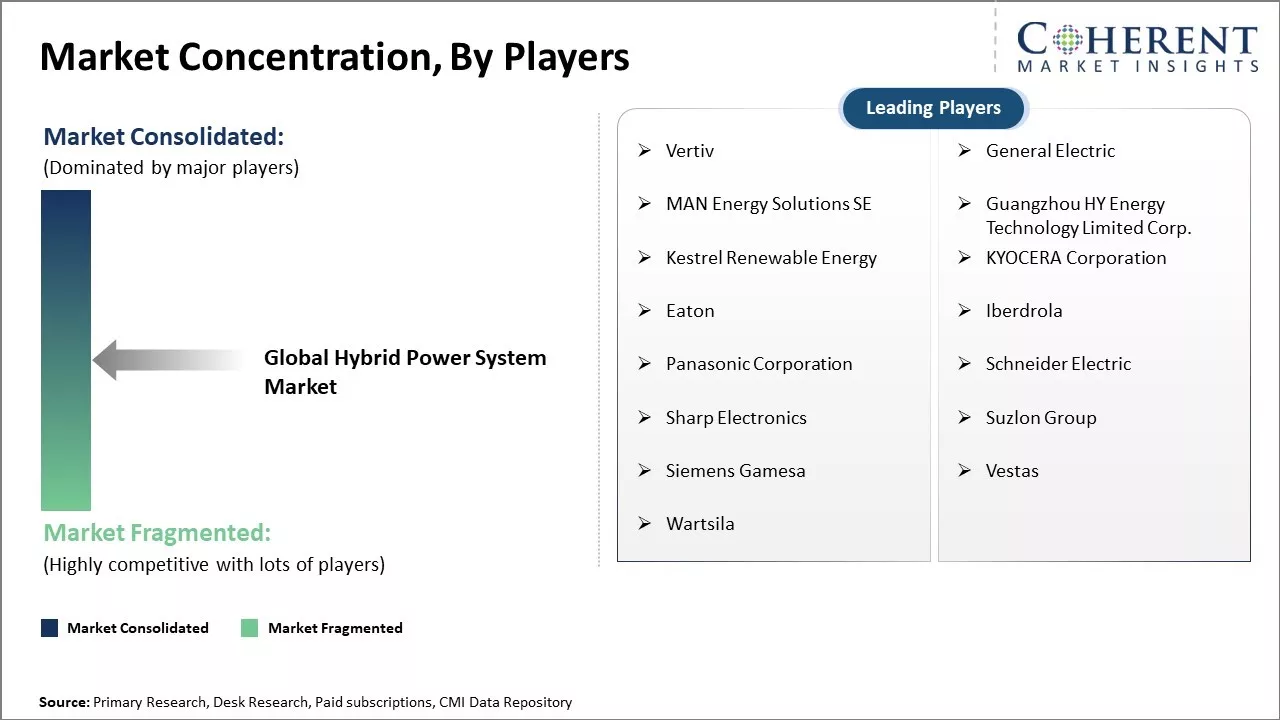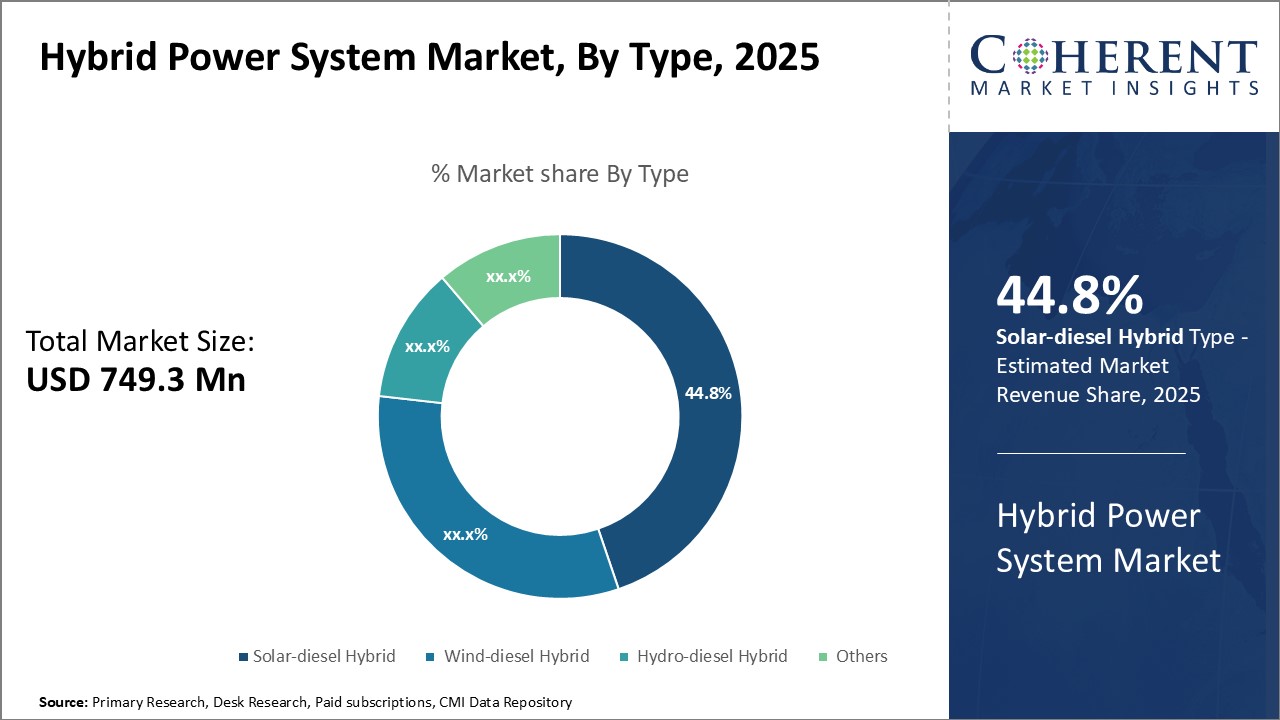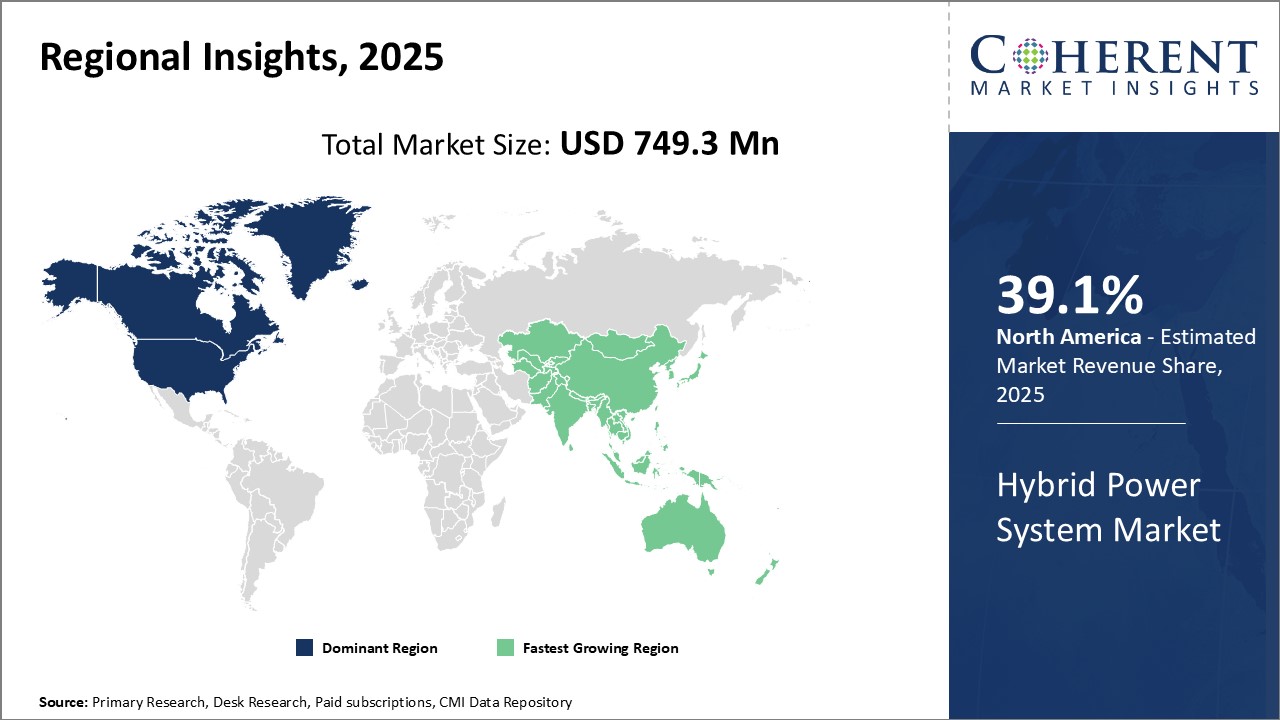The hybrid power system market is estimated to be valued at USD 749.3 Mn in 2025 and is expected to reach USD 1,157.6 Mn by 2032, exhibiting a compound annual growth rate (CAGR) of 6.4% from 2025 to 2032.

Discover market dynamics shaping the industry: Request sample copy
The market is witnessing significant growth over the forecast period due to the increasing demand for reliable power supply from both grid-connected and off-grid applications across the world. The hybrid power system market is majorly driven by the cost benefits of hybrid systems over conventional diesel generator sets. Hybrid power systems provide reliable and uninterrupted power supply while reducing fuel costs associated with diesel generators. Additionally, the need to lower carbon footprints along with the support from various governments worldwide in the form of subsidies is further fueling the demand for hybrid power systems during the forecast period.
Increasing global concerns over environmental pollution
As climate change concerns grow across the world, governments and organizations are focusing their efforts on curbing carbon emissions and adopting greener solutions. Hybrid power systems that integrate renewable energy sources like solar and wind along with battery storage offer a viable way to reduce dependence on fossil fuels. These systems can help off-grid communities meet their energy needs in an environmentally sustainable manner without polluting the air or water. The hybrid approach allows the optimal use of available renewable resources throughout the day and season. It ensures uninterrupted power supply even during gaps in rain or sunlight.
Many countries have announced ambitious climate change action plans and carbon neutrality targets for the coming decades. Transitioning to hybrid renewable energy systems for both on-grid and off-grid applications is seen as a major step towards achieving long-term decarbonization goals. Several policy incentives like tax benefits, feed-in tariffs, and subsidies are encouraging businesses and homeowners to install hybrid solutions. International bodies are also supporting developing nations through funding and technical aid to establish hybrid power projects, especially in rural locations lacking grid connectivity. As environmental regulations get more stringent worldwide, hybrid power will play a crucial role in curbing reliance on dirty fossil fuels. This is expected to significantly drive the global demand for hybrid power systems over the next 10 years.

Get actionable strategies to beat competition: Request sample copy
Rising electricity needs of remote communities
While power grids are expanding to reach new areas, plenty of remote locations across the world still lack access to centralized electricity. Reliance on costly and polluting diesel generators to meet their needs is not a sustainable long-term solution. Hybrid systems offer a reliable alternative by leveraging the natural renewable energy sources found near these communities. Solar-wind-battery hybrids can be easily set up to provide electricity for homes, farms, schools, and small enterprises located far from existing transmission networks. They reduce fuel transportation costs and are less prone to price volatility in oil markets.
Remote regions with good solar irradiance and wind potential like villages in Australia, islands in Southeast Asia, and off-grid mines in Africa are rapidly adopting hybrid power. As populations grow in these areas, their energy demands will also rise steadily which can be sufficiently met through an optimized hybrid system design. Some communities are even generating surplus power using hybrids that is sold back to main grids or nearby markets. This helps improve rural livelihoods and bridge the energy access divide. With their versatile ‘anywhere’ capability, hybrid systems will continue playing a pivotal role in electrifying the world’s most inaccessible areas.
Key Takeaways from Analyst:
Rapid electrification initiatives globally along with lowering costs of solar and wind technologies will drive the increased adoption of hybrid systems. Governments are promoting hybrid solutions to meet rural electrification targets in a sustainable manner. Favorable net metering policies also encourage commercial and industrial prosumers to install hybrid systems.
North America currently dominates the hybrid power system market and is expected to continue its lead. Africa presents significant untapped opportunities due to lack of grid access in many regions. Mini-grid solutions combining solar, wind, and diesel are gaining traction here. Meanwhile, developed nations in Asia Pacific and Europe will see growth from hybrid installations complementing existing utility grids.
Cloud computing applications and the electric vehicle charging infrastructure will boost opportunities for hybrids to provide reliable power. Their ability to seamlessly integrate various renewable sources and energy storage makes them an appealing option for microgrids and data centers. Hybrid systems can also play a crucial role in corporate sustainability goals through on-site renewable power generation. Developing standardized products and business models catering to different markets will help manufacturers scale up globally.
Market Challenges: High initial investment
One of the major challenges faced by the hybrid power system market is the high initial investment cost required for the setup and installation of hybrid power systems. Hybrid power systems combine two or more power generation sources like solar panels, wind turbines, diesel/gas generators, etc. and storage batteries. The components required for hybrid power systems like battery banks, charge controllers, inverters, etc. are quite expensive. For example, lithium-ion batteries that are commonly used in hybrid power systems have very high upfront costs. Similarly, installation of solar panels or wind turbines also involves substantial initial investment. The total initial setup cost of hybrid power systems can be two to three times more than conventional diesel generator systems. This high initial cost poses a major barrier for their widespread adoption, especially in developing countries and remote off-grid areas.
Market Opportunities: Growing emphasis on use of clean and renewable energy sources
The growing emphasis on the use of clean and renewable energy sources across the globe presents a huge opportunity for the hybrid power system market. Many countries have an ambitious target to increase the share of renewable energy in their overall power generation. Also, there is a pressing need to provide reliable and affordable electricity to remote off-grid communities which rely on polluting and expensive diesel generators. Hybrid power systems with their ability to seamlessly integrate different renewables and energy storage are ideal to meet both these needs. The flexibility of hybrid systems allow their configuration as per local resource availability and load requirements. Furthermore, factors like technology cost reductions, favorable government policies, and innovative business models are making hybrid power systems a commercially viable solution. All these factors present a massive opportunity for the hybrid power system market to grow exponentially in the coming years.

Discover high revenue pocket segments and roadmap to it: Request sample copy
Insights by type: Increasing demand for reliable renewable energy systems
In terms of type, the solar-diesel hybrid segment is expected to contribute 44.8% share of the market in 2025. The solar-diesel hybrid segment holds the largest share in the type category due to the rapidly growing demand for reliable renewable energy generation systems. Solar-diesel hybrid systems integrate solar photovoltaic panels with diesel generator sets to provide a sustainable power solution. The solar panels charge batteries during the day to meet daily power needs and reduce fuel consumption and emissions. These systems offer many advantages over standalone diesel generators such as lower operating costs, fuel savings, and reduced carbon footprint.
Rising energy costs and growing environmental consciousness have increased interest in solar power worldwide. However, solar energy alone cannot meet round-the-clock demand due to variability in sunlight. The solar-diesel hybrid model effectively overcomes this challenge through its ability to seamlessly switch between solar and diesel power according to the load and sunlight availability. Its high reliability in ensuring uninterrupted supply has made it an attractive option for off-grid applications in the commercial, industrial and residential segments. Stringent emission regulations in many countries are also driving the adoption of hybrid systems for their superior green credentials over diesel generators. With technological improvements continuously enhancing the feasibility of solar-diesel integration, this segment is expected to continue dominating the type category.
Insights by End-use: Commercial segment holds the largest share in terms of End-use
The commercial segment is expected to account for 41.7% of the market share in 2025, within the end-use segment as hybrid power systems have emerged as a cost-effective and eco-friendly solution for commercial establishments. Ranging from telecom towers and rural healthcare centers to ATMs and small businesses, a variety of commercial facilities rely on hybrid systems for their electricity needs. Constant power supply is critical for commercial operations and solar-diesel hybrids fulfill this requirement through their non-stop power generation capability.
Compared to grid extension, these decentralized hybrid systems offer commercial users a convenient 'generate-your-own power' option at lower long-term costs. Their ability to reduce fuel expenses by tapping into the free sun's energy plays a major role in accelerating their uptake. Hybrid technology also allows commercial clients to lower their carbon footprint and gain from its positive branding and marketing impacts. With commercial businesses accounting for a huge chunk of global energy consumption, the segment is poised to further stimulate hybrid power market growth through continued installations across varied commercial infrastructure.

Need a Different Region or Segment? Customize now
North America has emerged as the dominant region in the global hybrid power system market. The region is expected to account for 39.1% estimated share of the market in 2025. The region has high industrialization and urbanization rates, leading to massive electricity demands from various commercial and residential sectors. Stringent regulations regarding carbon emissions from diesel generators have compelled industries and commercial establishments to adopt hybrid power systems. Hybrid power systems provide an effective and sustainable solution to meet continuous power needs without hampering productivity or operations. Many oil and gas installations in Canada and the U.S. have replaced their conventional diesel generators with hybrid power systems for uninterrupted power supply as well as to reduce fuel costs. Furthermore, the region has a strong presence of tier-1 manufacturers and component suppliers of hybrid power systems, giving a fillip to local production and exports.
The Asia Pacific region has been witnessing exponential growth in the adoption of hybrid power systems and is emerging as the fastest-growing regional market. Rapid industrialization and infrastructure development activities in China, India, Indonesia, and Vietnam have heightened power demands. However, grid connectivity remains a challenge in remote and rural regions. Hybrid power systems have enabled reliable and affordable access to electricity for off-grid communities as well as industries located in such areas. Countries like Japan and South Korea are at the forefront of hybrid power technology and are increasingly exporting systems to other Asian markets. Additionally, lenient emission norms and low installation costs in developing Asian nations have made hybrid power an attractive proposition versus traditional diesel gensets. The price-sensitive nature and large customer base in Asia Pacific are expected to drive hybrid system deployment over the coming years.
Hybrid Power System Market Report Coverage
| Report Coverage | Details | ||
|---|---|---|---|
| Base Year: | 2024 | Market Size in 2025: | USD 749.3 Mn |
| Historical Data for: | 2020 To 2024 | Forecast Period: | 2025 To 2032 |
| Forecast Period 2025 to 2032 CAGR: | 6.4% | 2032 Value Projection: | USD 1,157.6 Mn |
| Geographies covered: |
|
||
| Segments covered: |
|
||
| Companies covered: |
Vertiv, General Electric, MAN Energy Solutions SE, Guangzhou HY Energy Technology Limited Corp., Kestrel Renewable Energy, KYOCERA Corporation, Eaton, Iberdrola, Panasonic Corporation, Schneider Electric, Sharp Electronics, Suzlon Group, Siemens Gamesa, Vestas, and Wartsila |
||
| Growth Drivers: |
|
||
| Restraints & Challenges: |
|
||
Uncover macros and micros vetted on 75+ parameters: Get instant access to report
*Definition: The hybrid power system market involves technology that generates and stores electricity from two or more sources to power homes and buildings. Hybrid power systems typically combine renewable energy sources like solar panels and wind turbines with diesel generators and batteries to provide a reliable and sustainable electricity supply. These modular hybrid power units can operate both on and off the main electric grid to power everything from remote homes and telecom towers to entire island microgrids and larger commercial facilities.
Share
Share
About Author
Yash Doshi is a Senior Management Consultant. He has 12+ years of experience in conducting research and handling consulting projects across verticals in APAC, EMEA, and the Americas.
He brings strong acumen in helping chemical companies navigate complex challenges and identify growth opportunities. He has deep expertise across the chemicals value chain, including commodity, specialty and fine chemicals, plastics and polymers, and petrochemicals. Yash is a sought-after speaker at industry conferences and contributes to various publications on topics related commodity, specialty and fine chemicals, plastics and polymers, and petrochemicals.
Missing comfort of reading report in your local language? Find your preferred language :
Transform your Strategy with Exclusive Trending Reports :
Frequently Asked Questions
Joining thousands of companies around the world committed to making the Excellent Business Solutions.
View All Our Clients
US Reciprocal Tax Impact Analysis On Hybrid Power System Market
Stay updated on tariff changes with expert insights and timely information